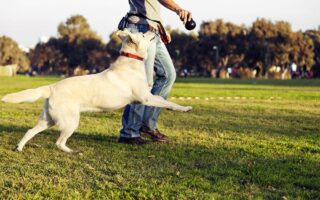The Journey to Independence: Understanding Seeing Eye Dog Training
In a world where mobility defines freedom, the bond between humans and their canine companions takes on a profound significance. For those with visual impairments, the partnership with a seeing eye dog transcends companionship; it’s a gateway to independence and autonomy. The training process behind these remarkable animals is an intricate dance of patience, skill, and unwavering trust—a journey that transforms playful puppies into life-altering aides. This article delves into the multifaceted world of seeing eye dog training, exploring the methods, the challenges, and the incredible impact these dogs have on the lives they touch. Whether you’re a dog lover, a supporter of assistive technologies, or simply curious about this unique bond, join us as we navigate the steps that lead to forging one of the most rewarding relationships known to humankind.
Table of Contents
- Understanding the Role of Seeing Eye Dogs in Enhancing Independence
- Key Training Techniques for Effective Guide Dog Development
- Building a Strong Bond: The Relationship Between Handler and Dog
- Support Resources for Aspiring Guide Dog Handlers and Trainers
- Q&A
- The Conclusion
Understanding the Role of Seeing Eye Dogs in Enhancing Independence
Seeing eye dogs are much more than loyal companions; they are highly trained service animals that play a crucial role in promoting autonomy among individuals with visual impairments. By guiding their handlers safely through various environments, these dogs enhance mobility and self-confidence. Through disciplined training, they learn to navigate obstacles, make vital decisions at crosswalks, and recognize cues unique to urban settings. The relationship formed between the handler and their canine partner goes beyond functionality; it fosters a sense of security and companionship that can transform daily experiences.
These extraordinary animals are typically educated in numerous essential skills, some of which include:
- Obstacle avoidance: Detecting and circumventing potential hazards in the environment.
- Direction guidance: Ensuring their handler reaches specific destinations efficiently.
- Social interaction: Facilitating communication with others by garnering attention and breaking down barriers.
Moreover, the impact of seeing eye dogs extends into the emotional and psychological realms. Many users report experiencing increased independence and reduced anxiety when accompanied by their service dog, as the bond formed provides a sense of reliability and support. In essence, the partnership created between the handler and their seeing eye dog not only enhances physical mobility but also contributes to a richer, more fulfilling life.
Key Training Techniques for Effective Guide Dog Development
Successful guide dog training hinges on several essential techniques that foster a deep bond between the handler and the canine. Positive reinforcement plays a pivotal role, where rewards such as treats or praise encourage desirable behaviors. This method not only primes the dog to respond well but also creates a joyful learning environment. Additionally, consistent socialization is crucial; exposing the dog to various environments, sounds, and experiences helps them adapt and thrive in public settings. This inclusion aids in building confidence, ensuring that they can navigate busy streets, crowded places, and other stimuli without becoming anxious.
Another effective technique is clicker training, which utilizes a distinct sound to mark specific behaviors at the moment they occur. This auditory cue helps the dog understand exactly what action led to a reward, enhancing their learning speed. Moreover, incorporating obstacle courses into training sessions can provide dynamic challenges that reinforce problem-solving skills and spatial awareness. It is also essential to maintain a structured routine during training. Regular schedules not only establish predictability for the dog but also help reinforce their learning. Implementing these techniques can lead to a well-adjusted guide dog, equipped with the skills necessary to assist their owner effectively.
Building a Strong Bond: The Relationship Between Handler and Dog
Establishing a deep connection with a seeing eye dog is essential for effective partnership and communication. The bond between a handler and their service dog forms the foundation for trust and reliability, crucial elements in navigating the world together. Through mutual respect and understanding, handlers can foster a positive relationship that encourages the dog to respond eagerly to commands. Techniques such as consistent training, positive reinforcement, and shared experiences not only strengthen this bond but also enhance the dog’s ability to perform tasks. Key elements to focus on include:
- Consistency in Training: Regular practice and clear commands help the dog understand expectations.
- Mutual Trust: Building trust allows the dog to feel secure in their role.
- Active Engagement: Engaging activities such as playtime or shared walks reinforce the connection.
Handlers should also prioritize an understanding of their dog’s unique personality and needs, adapting training methods accordingly to cultivate a stronger alliance. Establishing a routine not only offers comfort to the dog but also facilitates better responses to cues and tasks. When handlers acknowledge and celebrate their dog’s achievements—no matter how small—they feed into a positive feedback loop that motivates the dog to perform even better. This relational dynamic can be visualized in the following table:
| Handler Actions | Dog Responses |
|---|---|
| Consistent commands | Increased obedience |
| Positive reinforcement | Enhanced motivation |
| Regular bonding activities | Stronger connection |
| Adapting to dog’s needs | Improved comfort and trust |
Support Resources for Aspiring Guide Dog Handlers and Trainers
For those aspiring to become guide dog handlers or trainers, a wealth of resources is available to equip you with the necessary skills and knowledge. Start by exploring local organizations specializing in service dog training. These establishments often provide hands-on workshops, mentorship programs, and certifications that can significantly enhance your experience. Some recommended resources include:
- National Dog Trainers Federation - Offers expert advice and innovative training techniques.
- Guide Dogs for the Blind – Provides comprehensive courses on guide dog handling and training.
- Association of Professional Dog Trainers - Focuses on ethical training practices and professional development.
Furthermore, online platforms now host a plethora of educational materials tailored for aspiring trainers and handlers. From webinars to detailed training manuals, you’ll find various formats to suit your learning style. Consider the following online resources:
| Resource Type | Description |
|---|---|
| Webinars | Interactive sessions with industry experts focusing on practical guide dog training techniques. |
| Online Courses | In-depth programs covering behavior analysis, training methodologies, and canine psychology. |
| Discussion Forums | A platform for sharing experiences, advice, and best practices with fellow trainers and handlers. |
Q&A
Q&A: Unveiling the World of Seeing Eye Dog Training
Q1: What is a seeing eye dog?
A1: A seeing eye dog, also known as a guide dog, is a specially trained canine that assists individuals with visual impairments. These remarkable dogs provide mobility cues and help their handlers navigate through various environments safely and confidently.
Q2: How long does the training process take for a seeing eye dog?
A2: The training process for a seeing eye dog typically spans about 18 to 24 months. This extensive training begins with puppy socialization and foundational obedience, before progressing to specialized skills that focus on navigation and obstacle avoidance.
Q3: What breeds are commonly used for seeing eye dogs and why?
A3: Common breeds for seeing eye dogs include Labrador Retrievers, Golden Retrievers, and German Shepherds. These breeds are selected for their intelligence, temperament, and trainability, making them ideal companions for individuals with visual impairments.
Q4: What does the training process entail?
A4: The training process consists of several stages. Initially, a puppy undergoes socialization with diverse environments, sounds, and people. Following this, they learn basic obedience commands. In the final phase, the dog is trained to assist with specific navigation tasks, such as identifying curbs, doors, and hazards, while promoting independence for their handlers.
Q5: Who conducts the training for seeing eye dogs?
A5: Seeing eye dog training is conducted by skilled trainers at guide dog schools. These professionals are adept in canine behavior and teaching methods, ensuring that the dogs receive a well-rounded education. Additionally, individuals who will be paired with the dogs participate in training to learn how to work effectively with their new companions.
Q6: How are dogs matched with their human partners?
A6: The matching process involves careful consideration of both the dog’s temperament and the handler’s lifestyle, preferences, and mobility needs. Factors such as the handler’s environment, activity level, and even personality traits are weighed to ensure a harmonious partnership.
Q7: What are some challenges in seeing eye dog training?
A7: Some challenges in training include ensuring that dogs remain focused in distracting environments and teaching them to respond appropriately to complex situations. Trainers also must instill a strong work ethic in the dogs while ensuring they can relax and enjoy downtime with their handlers.
Q8: Can anyone apply for a seeing eye dog, and what is the process?
A8: Yes, individuals with visual impairments can apply for a seeing eye dog. The process usually involves an application, a telephone interview, and an in-person assessment to evaluate the applicant’s needs and readiness. Each guide dog school has its own criteria and waiting lists, but most are dedicated to finding the right match for those in need.
Q9: How does having a seeing eye dog impact someone’s life?
A9: The impact of having a seeing eye dog is profound; it promotes greater independence, confidence, and mobility for individuals with visual impairments. These dogs become beloved companions and play a crucial role in facilitating not just physical navigation but emotional support and social interaction.
Q10: What can the public do to support seeing eye dogs and their handlers?
A10: The public can support seeing eye dogs and their handlers by educating themselves about their needs and challenges. It is important to respect working guide dogs by avoiding distractions, allowing them to focus on their tasks, and understanding the importance of their role in their handler’s life. Additionally, supporting local guide dog schools through donations or volunteering can make a significant positive impact.
In a world where independence is invaluable, seeing eye dog training stands as a testament to the bond between humans and their canine companions—a partnership founded on trust, training, and transformation.
The Conclusion
As we draw the curtain on this exploration of seeing eye dog training, it’s clear that the journey is as profound as it is essential. These remarkable partnerships transform lives, unlocking the world for those who navigate it without sight. The dedication of trainers and the unwavering spirit of guide dogs create a bond that transcends mere assistance, fostering independence and empowerment.
Through patience, resilience, and understanding, both dogs and their handlers embark on a shared adventure, learning to navigate challenges together. As we reflect on the intricate dance of training, we’re reminded that every wag of a tail signals hope, and every step alongside a guide dog symbolizes the promise of a brighter, more accessible future.
In this ever-evolving field, the commitment to enhancing the lives of individuals with visual impairments remains steadfast. As we continue to advocate for awareness and support in this vital area, may we all champion the incredible abilities of these extraordinary canines and the profound impact they have on the lives they touch.



